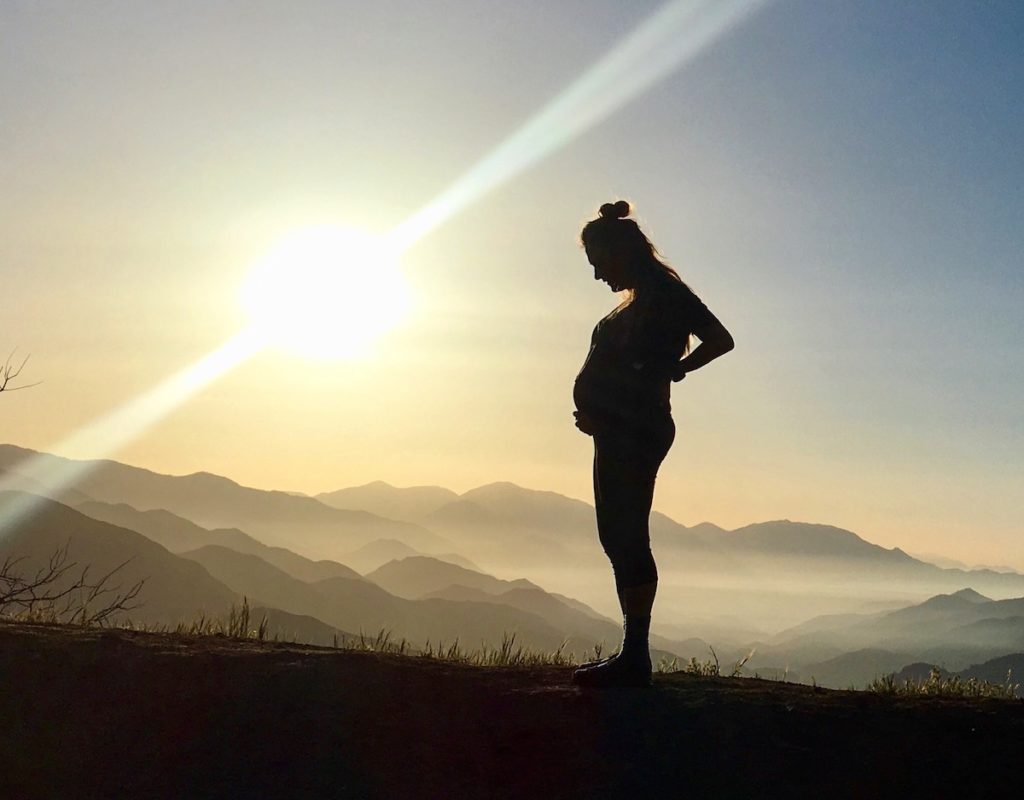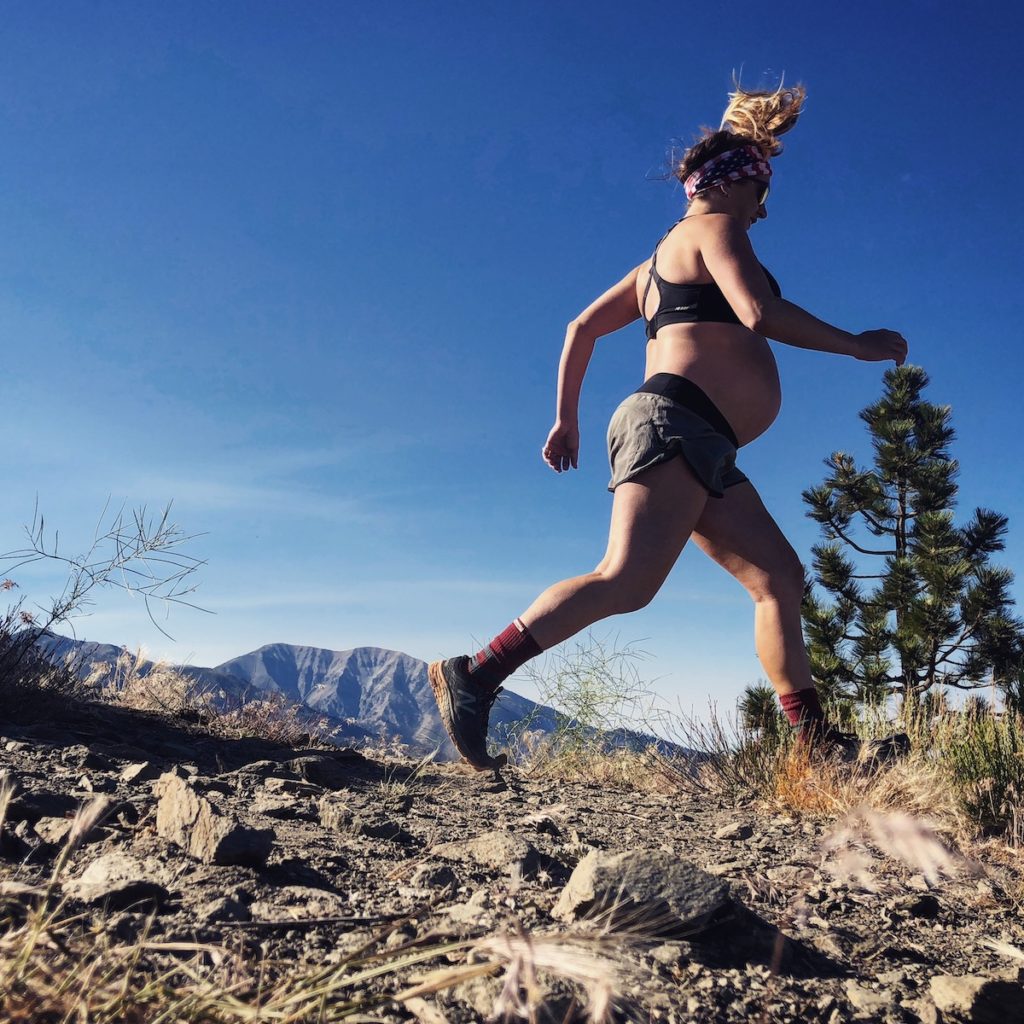Main Menu
The Race for Our Lives: America’s Maternal Mortality Crisis

Katie Grossman is a freelance advertising and outdoors writer based in Wrightwood, CA. She’s expanded her repertoire to include Mountain Ultra Trail runner, wife, backcountry skier, and mama of 2 little trail sisters – in that chronological order.
Share This Article!


By: Katie Grossman
*Part of our greater mission at Trail Sisters is education. This piece was created to help shine light on an unfamiliar and often unknown topic affecting American women and disproportionately, women of color. While this is a bit of a departure from our typical trail running content, there is a way to use your miles to get involved at the end of the article.
My first pregnancy ended in an emergency C-section, knocked out under general anesthesia. My husband was left alone in a hallway, as alarms sounded and a flurry of doctors and medical personnel rushed into the operating room. A nurse eventually emerged to let him know that his newborn daughter was fine, and with the sigh of relief came the seemingly obvious inquiry as to the status of me, his wife. The response? “I don’t know. Let me check.”
He was rightfully concerned. While the global maternity mortality rate has dropped by 44 percent worldwide between 1990 and 2015, and by 48 percent in developed countries, the US is one of only 13 nations who has seen its maternal death rate rise. That’s the US, as in the United States of America, as in a first-world developed country, as in the people who, half a century ago, sent a man to the fucking moon. We currently rank 55th in maternal deaths among all countries in the world, and DEAD LAST among similarly wealthy, developed nations. Even worse, the CDC Foundation estimates that a full 60 percent of these deaths are preventable.
“Today, a woman is twice as likely to die from pregnancy-related complications as her mother was a generation ago.”
Here’s the thing, though: my chances of survival were relatively good. For starters, I am a fit and healthy person with no preexisting conditions and enjoyed an uncomplicated pregnancy – complete with valuable prenatal testing to confirm my low risk. In addition, I happen to live in California, where advocates at the state level have reduced the maternal death rate to a third of the national average. But the one thing that most safeguarded my life had nothing to do with anything resulting from my own choices or efforts, nor from my good fortune in the Punnett squares. My chances of surviving childbirth were drastically improved because I am white.
The year 2020 has seen, amongst other disasters, a global pandemic, the following global recession, a rollback on women’s rights and reproductive health, a rising fight against the systemic racism that has plagued our country since its inception, and yeah – that on-going maternal mortality crisis that you likely didn’t even know about. In the center of that unholy Venn Diagram, you’ll find our country’s Black, Brown, and Indigenous mothers who are 2-3 times more likely to die from pregnancy and childbirth-related causes. But that is not a new statistic – researchers have known about both the crisis and the disparity for decades. Current challenges are only exacerbating the already existing problem.
You may find yourself (read: absolutely are) asking how, with all of the medical advances we have seen over the last century, women are somehow more likely to die in pregnancy and childbirth today than a generation ago. To be certain, a portion of the higher rate of maternal mortality correlates with the rise in chronic diseases, obesity, and advanced maternal age. However, the complications accounting for nearly 75% of all maternal deaths are severe bleeding, infections, high blood pressure during pregnancy (pre-eclampsia and eclampsia), complications from delivery, and unsafe abortion. In other words, nothing related to lifestyle choice and certainly nothing related to the color of a woman’s skin.*
*There is ongoing genetic research into links between race/ethnicity and certain pregnancy complications, but nothing conclusive as it relates to maternal mortality rates at this time.
In addition, a recent rise in numbers can be attributed to the fact that for the first time in over a decade, we finally have a more accurate estimate. Vital records like death certificates are governed by state laws and procedures and no national funding was provided when the adoption of a checkbox to help identify pregnancy-related deaths was recommended. This left states to rely on diverse funding to support the effort – hence the lag in having a more accurate data collection method on the national level, as well as ever-fluctuating statistics over the past decade, as advocates were forced to rely on various independent studies. Like most things pregnancy and birth, simply surviving the experience has astonishingly not been very precise or evidence-based.
Even with the adoption of the checkbox, the data will continue to be problematic, as the new rate excludes moms over 44 years of age and only examines deaths within 42 days of birth. According to the CDC, at least 24 percent of maternal deaths are happening six or more weeks after a woman delivers and researchers are only beginning to discover how conditions like certain cardiac problems and pre-eclampsia may continue to affect women long after birth. Additionally, the official World Health Organization (WHO) definition of what constitutes as a maternal death doesn’t include causes they deem “accidental” – things like domestic violence, drug overdose, and suicide – outcomes often closely linked to Postpartum Depression. I could spend an entire article delving into the myriad of ways we’re not getting an accurate picture here, but the larger point is that it has taken until the year 2020 for America to even begin collecting more standardized data on this crisis. It’s going to be a while before we get our collective shit together. All that being said, while specific numbers are fluctuating, the dismal trends in this country are not, with The National Center for Health Statistics (NCHS) formally stating the following: “New NCHS work does not fundamentally change our understanding of the magnitude of the problem and reinforces the significant black–white differential in maternal mortality.”
So let’s dig into that, shall we? It should come as no surprise that both implicit bias and structural racism affect outcomes for women in both accessing and utilizing health care. The larger systems of inequities – the ones we’ve been lining the streets to protest – have no doubt created the disparity in birth outcomes. To believe it isn’t connected to the larger battle for social justice and human rights would be whatever is worse than naive.* Many are quick to dismiss the disparity as one linked to poverty versus race, but consider this: a New York City analysis of five years of data concluded that college-educated Black mothers were more likely to suffer complications in pregnancy and childbirth than white women who never graduated high school. A full one in three people of color giving birth in a hospital reports experiencing disrespectful care or mistreatment.
*Stupid comes to mind, but I digress.
Further increasing the burden (and here’s where I get those “ohhhh, I see how we get here” heebies while watching The Handmaid’s Tale) is a leading theory that perhaps the problem with America’s maternal mortality rate is that historically, America doesn’t value women. One need not look further than the wage gap, the #MeToo movement, the woeful parental leave policy, the accompanying childcare dilemma, and the never-ending war for reproductive rights to get a taste of how our modern society views women. It’s not just our healthcare system that is failing to care for us – it’s the system in its entirety.

It should come as no surprise then that there is an increasing cause for concern for pregnant women and disproportionately, pregnant women of color in the current COVID-19 pandemic. Access to quality prenatal care and enlisting a birthing support person (husband, doula, etc.) have been shown to improve mortality and complication outcomes – rights that are not prioritized, and therefore tenuous, as cases spike and hospitals employ ever-changing policies. As an example, a portion of the prenatal visits for my current pregnancy have been designated to telehealth since I am over 35 years of age but otherwise low-risk – relying on my ability to self-report. I feel good about this, as I am likely more educated than most on women’s health and this is my second child, but what about women with no prior experience, no guidance, and armed only with the source of all pregnant women’s anxiety, Dr. Google? I also cannot bring anyone with me to my appointments including my daughter, who I must find childcare accommodations for in the time of COVID closures. Fortunately, my husband is working from home and, armed with Netflix and cookies, can cover it – but what about the women that must choose between their partner’s/their own essential job or their prenatal appointment? And to address my own fears – what if cases spike again next spring and I am forced to give birth alone without anyone there to watch over and advocate for me if I have another complicated experience? In this, I take no solace in the color of my skin; only anger. Anger that communities who already face disparities are going to have it way worse.
While the forecast surrounding maternal health may seem grim, there is a spark of hope. The one-two punch of a global pandemic and the public reckoning on racism have driven the introduction of bicameral legislation to directly address the maternal mortality crisis during COVID-19. Policymakers are listening to groups who have long advocated for justice in maternal care and recognize how problematic it is that Congress has yet to pass any legislation specifically focused on the pandemic’s maternal impact, despite the fact that there are close to FOUR MILLION live births each year. To date, not a single cent of the billions of dollars the federal government has poured into developing a vaccine will be used to include pregnant or lactating people in clinical trials. Given that there are an estimated 6.3 million women pregnant in this country at any given time coupled with what we currently know about the disease’s effects and morbidity, this feels… alarming. The Maternal Health Pandemic Response Act, if passed, would address the issues above as well as demand an explicit focus on improving birth outcomes for non-White people and women in rural areas.
The COVID-specific legislation is a necessary and time-critical step at the federal level, but American mothers were needlessly dying long before the pandemic and without swift action at every node of the system that created the crisis, they’ll continue to suffer. We need meaningful, scientific data on the federal level concerning not only how many women are dying, but why. We need federal funding for research and support. We need more standardized hospital training in childbirth complications and implicit bias training to counter discrimination. We need greater BIPOC representation in the medical workforce. We need to build social systems that allow women to receive critical postpartum care and reexamine Medicaid, which currently drops a woman from coverage at only 6 weeks postpartum.* We need increased medical care for all women in the months after childbirth – first to combat morbidity, and further to address the multitude of postpartum health issues that standard health care neither diagnoses nor supports. We absolutely must make birth more equitable for Black and Indigenous Americans. Birth is one of the most universal female experiences. Yet somewhere between 700 and 900 new and expectant mothers die in the U.S. each year, and an additional 500,000 women experience life-threatening postpartum complications. If those numbers seem small compared to other causes of death in this country, I’ll remind you again that the majority of those deaths are completely preventable. That is the very definition of tragic.
*For reference, I didn’t even stop bleeding until 9 weeks postpartum, and my C-section incision took months to begin healing. I received greater care for a minor ear infection.
It’s a LOT of work, no doubt. But I’m heartened by the fact that the work is clearly already being done. Over the past decade, many of my closest friends and later, myself have given birth and our experiences have certainly evolved. When a close friend nearly died from pre-eclampsia after giving birth in 2014, the condition was relatively unheard of and she was extremely fortunate there was a nurse on duty who recognized her shortness of breath as a sign. By 2017, I was educated by my provider on pre-eclampsia and eclampsia, regularly screened for blood pressure irregularities throughout my pregnancy, and even required to self-check with a home monitor and report daily in the days after my hospital discharge. Pregnant again in 2020, I fully expected to fight for an intended VBAC (Vaginal Birth After Cesarean), but was pleasantly surprised that it is now what most OB/GYNs in my healthcare provider recommend. (When research began to indicate a link between increased C-section rates and life-threatening complications, they began work on reducing C-sections.) I dream of the day postpartum care is more comprehensive and pelvic floor therapy is standard, but from the advancements I’ve seen in a relatively short period, I believe we’ll eventually get there. We just have to keep going.
Look, this affects everyone – not just because we all are, have, and/or know a mother – but because maternal mortality outcomes are actually one of the key indicators of a country’s overall health and socioeconomic development. As we dive into the weeds of fixing the problem in America, things will be complicated, and it will unavoidably get political. But at its core, the idea is simple:
When we take better care of women, we take better care of everyone.
Resources to Take Action:
Keep Learning.
The OB/GYN Podcast: Maternal Mortality series – Episodes 49, 59, and 67. A more scientific dive into data, what it all means, and how we got here.
Birth by the Numbers Even more data, research, and analysis.
Demand Better.
Add your name to the National Call for Birth Justice and Accountability. Then utilize their numerous resources to advocate for change, including info for contacting policymakers and toolkits for raising awareness.
Run!
Run the Race for Birth Justice with me on October 7th! Every Mother Counts is another great resource for education and action. Consider joining the team and running/raising funds with us, or make a donation of any amount*. All funds directly help underserved women access prenatal and postpartum care.
*I want to be sure to state here that while I set up the donation page linked above, all the funds are handled directly by Every Mother Counts. I chose to include my personal page versus a general donation link, as any funds I raise up to $50k will be matched by First Response™ – giving everyone a chance to double their contribution.
*Something to keep in mind as you’re learning – though women have been dying in childbirth since the dawning of time, the research into maternal mortality is a relatively new thing – first drawing attention around 2008. You’ll likely find a lot of surprising figures reported mostly between 2015-2018, and while the trends are the same – some of the data has changed with the CDCs recent report. I’ve found that the above resources are quick to reflect the most up-to-date information and are a good place to cross-reference.
About the Author

Katie Grossman is a freelance advertising and outdoors writer based in Wrightwood, CA. She’s expanded her repertoire to include Mountain Ultra Trail runner, wife, backcountry skier, and mama of 2 little trail sisters – in that chronological order.
Share This Article!




















One Response
Thanks for the great read, Katie. I try to avoid the phrase “first world” as it creates a theoretical hierarchy between wealthy nations and poor nations, or “third world countries.” I also would like to note you mentioned that there are studies regarding race and birth outcomes. I think that those studies should be regarded with skepticism as race is a social construct and our social system creates the disparities that women of color experience related to child birth.